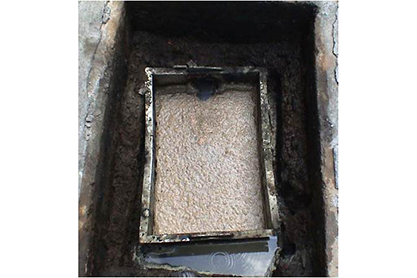
Case Study: Fast Food Restaurant Grease Trap Interceptor
A fast food restaurant faced growing problems with the grease interceptor located in the facility. The grease trap needed to be pumped every 6 months and the effluent was exceeding discharge limits.
 |
|
Thick with grease, cleaned every 6 months |
The management group elected to treat the problem with Orb-3 Wastewater Treatment Enzyme, and reported the following treatment results:
|
PARAMETERS |
13 November |
18 December |
|
| WTA04-1. BIOCHEMICAL OXYGEN DEMAND (BOD5), mg/L (By Azide Modification Dilution Technique) |
2579 |
850 |
700 |
| WTA05-1. CHEMICAL OXYGEN DEMAND (COD), mg/L (By Open Reflux) |
6320 |
1407 |
1400 |
| WTA24-1. pH VALUE at 24 C (By Glass Electrode) |
4.44 |
4.7 |
6.5 - 9.0 |
| WTA41-1. TOTAL SUSPENDED SOLIDS, mg/L (By Gravimetric, Drying to Constant Weight at 103 - 105 C) |
1500 |
147 |
980 |
| WTA23-1. OIL AND GREASE, mg/L (By Gravimetric - Petroleum Ether Extraction) |
203 |
12 |
70 |
A visual inspection of the treated contaminant also showed a marked difference over the 1-month period.
|
|
|
|
Effluent Sample Before Treatment |
Effluent Sample After Treatment |
Continued treatments with enzymes have reduced pumping requirements, put the restaurant back in line with discharge limits, tamed the foul odors, and restored the operation of the drain lines.

